In many parts of the world, wood shingle roofing is a premium roofing system used to provide homes with the perfect rustic look.
Wood shingles are roofing materials that are obtained by sawing blocks of wood. They were a common feature in the early 20th century, and they are still widely used even today. With the advent of technology and machines, wood shingles have become even smoother and uniform and can now be mass-produced in much larger quantities.
Wood shingles are not only made from Cedarwood but can also be sawn from other big trees. They are used for roofing and to cover the walls of buildings. They are thinner than shakes and can also be vulcanized with rubber to increase their resistance to impact and water.
Contents
- Difference between Cedar shakes and Wood shingle roofs
- Types of Wood shingle roofs
- Advantages and Disadvantages of Wood shingle roofs
- Installation and Maintenance of Wood shingle roofs
- Conclusion
Difference between Cedar shakes and Wood shingle roofs
Wood shingles and Cedar shakes are very similar, but not the same. The differences between them will be discussed below to guide you to the roof of your dreams.
Appearance
Wood shingles are uniform and smooth, while Cedar shakes are rugged in appearance. Cedar shakes were traditionally split from wood using axes and mallets, while wood shingles were sawn from woodblocks. Today, shakes are given a rough, rugged texture on one side and a smooth texture on the other. Wood shingles all look similar to the next, resembling wooden tiles, while cedar shakes vary slightly.
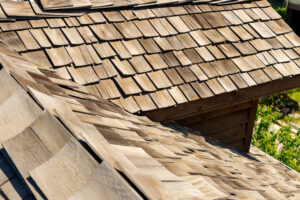
Also, shingles are thinner and lighter than shakes. Wood shingles are thin in their texture, while shakes have a thicker and rigid appearance and give a roof beautiful depth and dimension. Wood shingles have a regular, repeating appearance and provide a flat, even surface.
Cost
Since they are thinner than shakes, shingles contain lesser wood overall than shakes and are therefore less expensive. They are also cheaper to install since they require lesser effort and smaller nails. However, their installation requires more precision to avoid damaging the individual shingles and the overall roof.
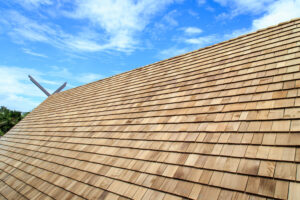
Longevity
Due to their thickness and rigidity, cedar shakes are more durable and last longer than wooden shingles because they are thicker and made from premium-grade wood. Shingles are more susceptible to damage from intense wind storms, water and moisture, hail, and sunlight rays.
Types of Wood shingle roofs
Generally, wood shingles are classified based on their origins. Depending on the tree the wood they are from was gotten or what was involved in producing them. We have the following types.
Cedar Shingles
Cedar shingles are obtained from cedar wood, commonly found in the Northwestern parts of the USA. Cedar is a coniferous wood known worldwide for its beauty, versatility, pleasant odor, and strength. Cedar tree leaves remain green throughout the year, and the trees grow more than 30 meters.
Shingles made from cedar are the most popular, and due to this, wood shingles are commonly referred to as cedar shingles. They are very durable and are the cheapest wooden roof shingle. Also, their surface texture is uniform, and they have a fine grain that is easy to work into any desired shape.
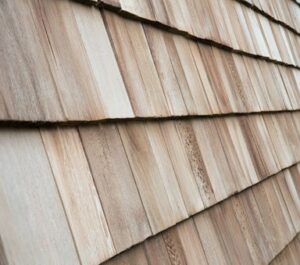
With proper maintenance, they can last well more than 4 decades. They can withstand adverse operating conditions which damage other roof types. Due to their low density, they retain their shape and size after years of service under extreme changes in climatic conditions such as rain, snow, heat, windstorms, etc.
Wallaba Shingles
Wallaba is a reddish-brown wood common in Southern America. It is used for making shingles in South America and other parts of the world. It is unique in that it contains oily resins and gum. Wallaba shingles are primarily used in tropical regions because they are resistant to pest attacks such as termites and adverse climatic conditions.
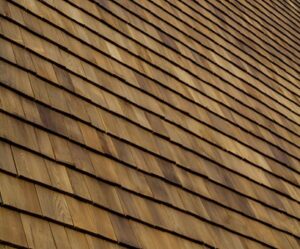
Due to its pleasing appearance, it is used for roofing several buildings of different heights and styles. They are used on large historic buildings, private residences, and lots more. They cost lesser than teak shingles and change their hue slightly over their service life but retain their integrity.
They are perfect for roofing in places with variable weather conditions and long durability requirements. Over time, the shingles become more reflective, helping to cool homes in the hot weather. Wallaba shingles require no additional preservative chemicals thanks to the oils found in them, making them easily disposable without damage to the environment. They can last for up to 50 years.
Teak Shingles
Teak shingles are derived from teak wood gotten from mint trees commonly found in Southern Asia. They are rich in natural oils and are used for making shingles because they have high water resistance and resist the growth of mold, moss, and algae. Due to their strong water resistance, they are suited for houses in locations with a heavy quantity of rainfall annually.
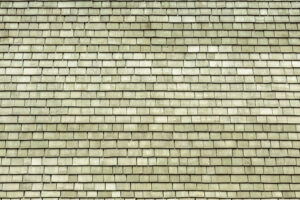
They are the priciest of the wood shingles due to their attractive lush looks and ability to remain attractive after several years. They are very durable, with a lifespan above 50 years if maintained adequately. Despite exposure to moisture for several years, they do not soak water and shrink on drying.
Composite Wood Shingles
Just as the name suggests, composite wood shingles are made up of different materials or wood types. Composite wood shingles are used together to harness the individual strengths of the unit as a whole. They contain properties of all the different wood along the grain but remain lighter than the respective wood used, making them easy to install and replace if needed.
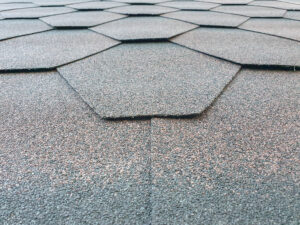
Their production is usually done industrially and can be modified as required to improve on a given quality, such as weight, strength, flexibility, fire resistance, water resistance, etc. Due to this, they are also referred to as synthetic wood shingles. Strength is not impacted, and they are most often more robust than the individual wood used.
They have numerous benefits over conventional wood shingles, such as higher resilience to harsh environmental conditions while retaining their color and improved fire resistance; thus, they are usable where building codes do not permit wood shingles. They can last well in advance of 50 years if designed with durability as a critical consideration.
Advantages and Disadvantages of Wood Shingles
Wood shingle roofs are similar to cedar shake roofs; they have similar advantages and disadvantages. Wooden roofs are premium and offer a rustic appearance for your home. However, it is imperative to run down the list of advantages and disadvantages to determine if it is right for you.
Advantages
The advantages of wood shakes are numerous due to the different types available and the flexibility of options. These advantages include.
Curb Appeal
Wood looks very attractive. Wood shingles on your roof give your home a warm, welcoming appeal, and this makes them the number one choice for many homeowners. Additionally, wood shingles fade as they age to give your home a countryside look. Wood shingles go well with houses with wood siding, bricks or stones, and other natural materials since they each have repetitive patterns.
Durability
Although they require proper maintenance, wood shingles can last for up to 50 years with the correct installation and maintenance. The lifespan depends on several factors such as the type of wood shingle, style, thickness, edge grain, cut type of the wood shingle, and its maintenance.
Lightweight
Compared to other conventional roof options such as concrete roof tiles, wood shingle roofs are much lighter in weight. Despite being lighter, they are strong and have high resistance to the elements. This weight reduction can be significant when designing the load-bearing structural members of the house.
Economy
Wood shingles cost about $3-$4 on average per square foot, which is more than the average price for asphalt shingles but lesser than other roof types such as metal roofs, tile roofs, etc. The cost of installing wood shingles is also economical since the installation process is relatively easy, thus, making wooden shingles roofs affordable.
Energy Efficiency
Wood shingle roofs add increased air circulation to your home. They generally provide insulation as the air rises through the wood and afford the option of adding extra insulation before installation. This insulation keeps the temperature regulated during extreme summer and water, affording savings on the cost of electricity. Wood shingles have good absorbent properties and do not only absorb heat but also sound.
Versatility
Wood shingles are versatile because they have different options and can be modified for use in different types of buildings and regions. They look great on both commercial and residential roof systems. Wood roofs have various style options with the option of specifying the size, length, thickness, type, the shape of the shingles, color, and grain of the shingles, making it possible to have a different roof.
Environmentally Friendly
Wood shingle roofs are natural materials obtained from natural sources, requiring no inorganic products. They are easily recycled for making mulch or animal beddings. Since they are biodegradable, they can be disposed of without damaging the environment. In producing wood shingles, trees cut down are often replaced, thus making them even more sustainable.
Disadvantages
The advantages of wood shakes are numerous due to the different types available and the flexibility of options. These advantages include.
Fire Resistance
Wood is not a fire-resistant material but rather a combustible one. Therefore, wood shingles are not the best roof in regions with a high risk of fires and wildfires, and they will likely burn and add to the fire.
Due to this, some certain states and regions have building codes that restrict or have banned the use of wood shingles, and some insurance companies do not insure wood shingle roofs. It is possible to coat the wood surface with some fire retardants to help reduce the combustibility of wood; however, they need re-application from time to time.
Pest Attack
If low-quality wood is used, they are at risk of being attacked by termites, wood borers, and other pests which cause damage to wood. These pests shorten the lifespan of wood shingles and make them vulnerable to other forms of attack. Also, some animals such as wasps and other birds may make their homes on the roofs. This can be a considerable disturbance as they may begin to extend into the house and possibly cause an infestation.
Susceptibility to Moisture
In places with a high quantity of annual rainfall and snow, wood shingles may not be the best option. Wood by its nature absorbs water when damp, and this causes it to expand. When the water dries out, it shrinks. This alternate expansion and contraction weaken wood shingles causes them to warp and develop leaks.
Wood shingles are more liable to leaks than other roofing materials because they are small and not water-resistant. As shingles crack and deteriorate over time, leaks can develop more rapidly and become widely spread, and this can become a big problem if not quickly addressed.
Additionally, when wood absorbs water and does not dry properly due to insufficient airflow, molds, mosses, and other plants can begin to grow on it. These plants further weaken the wood shingles and loosen the grain material. It is best to install a proper mesh material to allow the wood shingles to dry and breathe properly when wet.
Lightweight
Lightweight is both a blessing and a curse; while wood shingle roofs are light and help you save on sizes of supporting members and cost of installation, it makes them susceptible to strong winds. Suppose you are in a region with extreme weather. In that case, strong winds during heavy thunderstorms or tornadoes can affect your roof, especially if not correctly installed or if there has been some localized damage to an area.
Installation and Maintenance of Cedar shake roofs
Wood shingles require proper maintenance to reach their maximum lifespan. This and adequate installation combine to ensure your roof serves you as best as it can.
Installation
Due to their relative delicateness, the wood shingle installation is better left to professionals who have been trained to do so. This is to avoid damaging the thin sheets that combine to make the roofing system. There are various thicknesses and options to choose from, such as The Fivex (1/4 inches thick x 16 inches long), the Perfection (3/8 inches thick x 18 inches long), and the Royal (1/2 inches thick x 24 inches long), which can be installed by a competent roofing contractor.
Maintenance
Wood shingles need regular treatments with waterproof, fire-retardants, and fungicidal materials to enable them to stay sturdy and free of various harmful agents. Growing organisms and any other present debris on the roof will also have to be removed. It may be necessary to get rid of tree branches reaching too close to the roof to prevent them from falling and cracking the wood shingle.
Proper maintenance will give the roof a good look and enable it to remain strong and durable. It is possible to clean and maintain a wood shingle roof by oneself, equipped with the appropriate knowledge and tools.
Conclusion
Wood shingle roofs are an affordable and relatively durable roofing option. If you search for roof options for your home and are confident the weather, pests, and fire are not significant drawbacks, then wood shingle roofs may be just the perfect option for you. They are available in different types, styles, and costs and can be modified to make them just as you want them.
Olaseeni Ogunniyi is a professional technical writer with over 5 years of experience curating content in the engineering niche.
Thanks to his background in Civil Engineering, he has worked as a project manager and a consultant on several roofing projects, from simple hip and gable roofs to more complex combination roofs.
Additionally, he has written several projects on aluminum and metallic roofing sheets and has developed expertise on such topics.


1 thought on “A comprehensive look at Wood shingle Roofs”
Comments are closed.